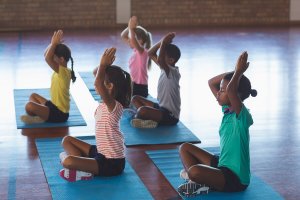Yoga for Children: First Steps

Parents often dream about their children staying calm for a few minutes, with closed eyes and without speaking! This isn’t impossible! Yoga for children can have a positive impact. In this article, we’ll cover everything you should know about this increasingly widespread trend.
Yoga for children?
Yes, exactly what you’re reading. Starting from four or five years old, children can now participate in yoga classes… and have a great time while doing it! As you might have heard, yoga practice has lots of benefits for kids.
As a first step, it’s good to know some of the advantages of yoga for children. Youngsters who do yoga on a regular basis boost their confidence and have greater concentration.
These children are also more flexible – which can be maintained into adulthood if they continue with the exercise -. With yoga, children develop their strength, become aware of their bodies and are less likely to suffer from stress and hyperactivity.
In turn, yoga allows children to work on their balance, establish a connection with their own bodies, activate their creativity, share spaces with other children and manage their emotions, as well as recognize them.
As if this weren’t enough, classes will regulate their physiological functions such as sleep and appetite. This gives them tools to have fun and entertain themselves without excessively relying on technology and screens.
Yoga for children can also help them to relax and make better decisions in a variety of everyday situations. It even reduces violence in schools and can prevent some eating disorders and fosters self-esteem.
Yoga, like with any other exercise, has many benefits for children. Nevertheless, it’s always a good idea to consult with your pediatrician before starting any new workout plan.
If you think yoga might be good for your child but they’re a bit too restless, maybe think about complementing your child’s exercise with some aerobic activity before yoga class. This option would allow them to release their pent-up energy and stay calm and engaged during yoga class.

What do yoga classes for kids look like?
Some yoga teachers indicate that children can start with their first classes from four or five years old. Still, this should be done more as a game and a chance to do an activity out of their home.
Thus, it’s only around seven or eight years old that the classes start to make more sense. From this age onwards, your children will be focused enough to get the real benefits from doing yoga.
For children and adults alike, it’s recommended to practice yoga at least twice a week. However, weekly sessions might be enough at the beginning, so your children have enough time to familiarize themselves with the dynamics and the exercises.
Each yoga session can last between 45 and 90 minutes. It’s advised that parents are present … and also practice yoga! If a parent practices yoga with their child, it’ll strengthen their bond. Plus, yoga for children helps the child overcome their insecurities about doing something unknown. In addition, it’ll be an excellent opportunity for dad or mom to enjoy a bit of quiet time, at least for a while!
Yoga classes for children are fun because they try to approach this discipline through games, songs, musical instruments and stories. They’re not taught conscious breathing exercises because they’re not yet prepared for them, but certain simple postures are made.
The main challenge is for the children to focus their attention on the teacher. It may be difficult for them to remain calm or to repeat the movements explained at the beginning, but they’ll soon understand what’s expected of them, and even replicate what they learned at home or at school.

Yoga classes for children shouldn’t be a chore
It’s never good to force your child to practice yoga. Nevertheless, it could be useful to try and give them the chance to accept it gradually. In order to do this, it’s essential that as parents we’re committed to the activity, both in class and at home.
Thus, if the child sees their parent doing yoga, they’re likely to be curious, ask or imitate her. The same happens in the classroom!
Find a yoga school that teaches children and adults simultaneously. But especially, find one where the sessions are fun and attractive for the child. If this doesn’t happen, you can always find another class or another teacher.
Finally, in addition to leading by example, it’s good to encourage tranquility and relaxation at home. It’s no use going to yoga class with your children if life is chaotic and stressful at home. Seek peace in and out of the class in order to improve everyone’s quality of life!
Parents often dream about their children staying calm for a few minutes, with closed eyes and without speaking! This isn’t impossible! Yoga for children can have a positive impact. In this article, we’ll cover everything you should know about this increasingly widespread trend.
Yoga for children?
Yes, exactly what you’re reading. Starting from four or five years old, children can now participate in yoga classes… and have a great time while doing it! As you might have heard, yoga practice has lots of benefits for kids.
As a first step, it’s good to know some of the advantages of yoga for children. Youngsters who do yoga on a regular basis boost their confidence and have greater concentration.
These children are also more flexible – which can be maintained into adulthood if they continue with the exercise -. With yoga, children develop their strength, become aware of their bodies and are less likely to suffer from stress and hyperactivity.
In turn, yoga allows children to work on their balance, establish a connection with their own bodies, activate their creativity, share spaces with other children and manage their emotions, as well as recognize them.
As if this weren’t enough, classes will regulate their physiological functions such as sleep and appetite. This gives them tools to have fun and entertain themselves without excessively relying on technology and screens.
Yoga for children can also help them to relax and make better decisions in a variety of everyday situations. It even reduces violence in schools and can prevent some eating disorders and fosters self-esteem.
Yoga, like with any other exercise, has many benefits for children. Nevertheless, it’s always a good idea to consult with your pediatrician before starting any new workout plan.
If you think yoga might be good for your child but they’re a bit too restless, maybe think about complementing your child’s exercise with some aerobic activity before yoga class. This option would allow them to release their pent-up energy and stay calm and engaged during yoga class.

What do yoga classes for kids look like?
Some yoga teachers indicate that children can start with their first classes from four or five years old. Still, this should be done more as a game and a chance to do an activity out of their home.
Thus, it’s only around seven or eight years old that the classes start to make more sense. From this age onwards, your children will be focused enough to get the real benefits from doing yoga.
For children and adults alike, it’s recommended to practice yoga at least twice a week. However, weekly sessions might be enough at the beginning, so your children have enough time to familiarize themselves with the dynamics and the exercises.
Each yoga session can last between 45 and 90 minutes. It’s advised that parents are present … and also practice yoga! If a parent practices yoga with their child, it’ll strengthen their bond. Plus, yoga for children helps the child overcome their insecurities about doing something unknown. In addition, it’ll be an excellent opportunity for dad or mom to enjoy a bit of quiet time, at least for a while!
Yoga classes for children are fun because they try to approach this discipline through games, songs, musical instruments and stories. They’re not taught conscious breathing exercises because they’re not yet prepared for them, but certain simple postures are made.
The main challenge is for the children to focus their attention on the teacher. It may be difficult for them to remain calm or to repeat the movements explained at the beginning, but they’ll soon understand what’s expected of them, and even replicate what they learned at home or at school.

Yoga classes for children shouldn’t be a chore
It’s never good to force your child to practice yoga. Nevertheless, it could be useful to try and give them the chance to accept it gradually. In order to do this, it’s essential that as parents we’re committed to the activity, both in class and at home.
Thus, if the child sees their parent doing yoga, they’re likely to be curious, ask or imitate her. The same happens in the classroom!
Find a yoga school that teaches children and adults simultaneously. But especially, find one where the sessions are fun and attractive for the child. If this doesn’t happen, you can always find another class or another teacher.
Finally, in addition to leading by example, it’s good to encourage tranquility and relaxation at home. It’s no use going to yoga class with your children if life is chaotic and stressful at home. Seek peace in and out of the class in order to improve everyone’s quality of life!
All cited sources were thoroughly reviewed by our team to ensure their quality, reliability, currency, and validity. The bibliography of this article was considered reliable and of academic or scientific accuracy.
- McGonigal, K. (2006). Yoga for kids. IDEA Fitness Journal.
This text is provided for informational purposes only and does not replace consultation with a professional. If in doubt, consult your specialist.








